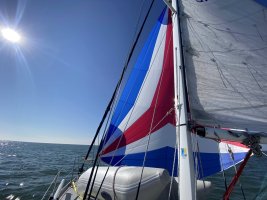Hello-
I am considering pulling the roller-furling off my boat* and trying to decide on hank-on jib sizes. Advice appreciated.
My use: sailing a boat with rig/hull similar to a 34-2 on central SF Bay, all year (summer 20-25 kt standard; winter 5-15 kt more common. I tend not to go out in less than 5 kt, though maybe your advice will change that. Would like eventually to do a Hawaii trip. I singlehand the bulk of the time. I find my current 100% roller-furling jib is fine up to around 20+, at which point I tend to head (downwind) home. It seems small in < 8 kts, and < 10 downwind. In higher wind I have been dropping the main and sailing under 100% jib alone (never furl, except all the way); this will change with the imminent advent of a new main with better (3) reefing options. Boat has a shoal keel, so more leeway/probably a bit less stiff than the usual Ericsons.
Advice from my sailmaker is to get a 90% and 135% to start, and maybe at some point a drifter out of lighter/cheaper material. Would get a small storm jib too if going to Hawaii, but that is not the immediate issue. I was thinking of getting only two jibs, since changing them all the time is a hassle and I am more likely to sail with a slightly off-size jib and try to compensate with trim rather than (like a racer) swap all the time.
I think I remember Christian used a 125% to Hawaii (?); unsure if I would be sorry with 135%. My (very limited) experience offshore of the bay area is that wind can be surprisingly low sometimes (despite the gale at the gate), but 150% sounds like it would just be too big, and a hassle to handle singlehanded. 90% seems like it might be a nice match with a reefed main at the ~ 25-ish summer windspeeds, but I'm used to 100% which has not been too bad.
Any advice appreciated.
* Roller-furling (or not) is a separate discussion (that likely involves strong opinions ; I would like to keep this thread about the sails, rather than the furling, though all comments from this site have been useful and appreciated so don't feel overly constrained.
; I would like to keep this thread about the sails, rather than the furling, though all comments from this site have been useful and appreciated so don't feel overly constrained.
PS: Yes, I searched this topic; most relevant I saw is below for any future searchers:
 ericsonyachts.org
ericsonyachts.org
I am considering pulling the roller-furling off my boat* and trying to decide on hank-on jib sizes. Advice appreciated.
My use: sailing a boat with rig/hull similar to a 34-2 on central SF Bay, all year (summer 20-25 kt standard; winter 5-15 kt more common. I tend not to go out in less than 5 kt, though maybe your advice will change that. Would like eventually to do a Hawaii trip. I singlehand the bulk of the time. I find my current 100% roller-furling jib is fine up to around 20+, at which point I tend to head (downwind) home. It seems small in < 8 kts, and < 10 downwind. In higher wind I have been dropping the main and sailing under 100% jib alone (never furl, except all the way); this will change with the imminent advent of a new main with better (3) reefing options. Boat has a shoal keel, so more leeway/probably a bit less stiff than the usual Ericsons.
Advice from my sailmaker is to get a 90% and 135% to start, and maybe at some point a drifter out of lighter/cheaper material. Would get a small storm jib too if going to Hawaii, but that is not the immediate issue. I was thinking of getting only two jibs, since changing them all the time is a hassle and I am more likely to sail with a slightly off-size jib and try to compensate with trim rather than (like a racer) swap all the time.
I think I remember Christian used a 125% to Hawaii (?); unsure if I would be sorry with 135%. My (very limited) experience offshore of the bay area is that wind can be surprisingly low sometimes (despite the gale at the gate), but 150% sounds like it would just be too big, and a hassle to handle singlehanded. 90% seems like it might be a nice match with a reefed main at the ~ 25-ish summer windspeeds, but I'm used to 100% which has not been too bad.
Any advice appreciated.
* Roller-furling (or not) is a separate discussion (that likely involves strong opinions
PS: Yes, I searched this topic; most relevant I saw is below for any future searchers:
Head Sail Size for 1989 E 38-200
My original equipment North Sail head sail is starting to require patching and I am eventually looking at the purchase of a new head sail.I currently have a roller furled 105.I sail shorthanded alot and race occasionally again with limited crew.I would be interested in opinions regarding head...

